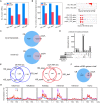Cotranscriptional and Posttranscriptional Features of the Transcriptome in Soybean Shoot Apex and Leaf
- PMID: 33897737
- PMCID: PMC8063115
- DOI: 10.3389/fpls.2021.649634
Cotranscriptional and Posttranscriptional Features of the Transcriptome in Soybean Shoot Apex and Leaf
Abstract
Transcription is the first step of central dogma, in which the genetic information stored in DNA is copied into RNA. In addition to mature RNA sequencing (RNA-seq), high-throughput nascent RNA assays have been established and applied to provide detailed transcriptional information. Here, we present the profiling of nascent RNA from trifoliate leaves and shoot apices of soybean. In combination with nascent RNA (chromatin-bound RNA, CB RNA) and RNA-seq, we found that introns were largely spliced cotranscriptionally. Although alternative splicing (AS) was mainly determined at nascent RNA biogenesis, differential AS between the leaf and shoot apex at the mature RNA level did not correlate well with cotranscriptional differential AS. Overall, RNA abundance was moderately correlated between nascent RNA and mature RNA within each tissue, but the fold changes between the leaf and shoot apex were highly correlated. Thousands of novel transcripts (mainly non-coding RNA) were detected by CB RNA-seq, including the overlap of natural antisense RNA with two important genes controlling soybean reproductive development, FT2a and Dt1. Taken together, we demonstrated the adoption of CB RNA-seq in soybean, which may shed light on gene expression regulation of important agronomic traits in leguminous crops.
Keywords: chromatin-bound RNA; co-transcriptional splicing; nascent RNA; non-coding RNA; soybean.
Copyright © 2021 Zhu, Zhao, Kong, Liu, Liu and Dong.
Conflict of interest statement
The authors declare that the research was conducted in the absence of any commercial or financial relationships that could be construed as a potential conflict of interest.
Figures







Similar articles
-
Comparative analysis of nascent RNA sequencing methods and their applications in studies of cotranscriptional splicing dynamics.Plant Cell. 2023 Nov 30;35(12):4304-4324. doi: 10.1093/plcell/koad237. Plant Cell. 2023. PMID: 37708036 Free PMC article.
-
Global Co-transcriptional Splicing in Arabidopsis and the Correlation with Splicing Regulation in Mature RNAs.Mol Plant. 2020 Feb 3;13(2):266-277. doi: 10.1016/j.molp.2019.11.003. Epub 2019 Nov 20. Mol Plant. 2020. PMID: 31759129 Free PMC article.
-
Quantification of co-transcriptional splicing from RNA-Seq data.Methods. 2015 Sep 1;85:36-43. doi: 10.1016/j.ymeth.2015.04.024. Epub 2015 Apr 27. Methods. 2015. PMID: 25929182
-
Total RNA sequencing reveals nascent transcription and widespread co-transcriptional splicing in the human brain.Nat Struct Mol Biol. 2011 Nov 6;18(12):1435-40. doi: 10.1038/nsmb.2143. Nat Struct Mol Biol. 2011. PMID: 22056773
-
Splicing in the human brain.Int Rev Neurobiol. 2014;116:95-125. doi: 10.1016/B978-0-12-801105-8.00005-9. Int Rev Neurobiol. 2014. PMID: 25172473 Review.
Cited by
-
Comparative analysis of nascent RNA sequencing methods and their applications in studies of cotranscriptional splicing dynamics.Plant Cell. 2023 Nov 30;35(12):4304-4324. doi: 10.1093/plcell/koad237. Plant Cell. 2023. PMID: 37708036 Free PMC article.
-
A simple and robust method for isolating and analyzing chromatin-bound RNAs in Arabidopsis.Plant Methods. 2022 Dec 12;18(1):135. doi: 10.1186/s13007-022-00967-y. Plant Methods. 2022. PMID: 36510301 Free PMC article.
-
Comparison of transcriptional activity profiling by metabolic labeling or nuclear RNA sequencing.Plant J. 2025 Aug;123(3):e70401. doi: 10.1111/tpj.70401. Plant J. 2025. PMID: 40795170 Free PMC article.
References
LinkOut - more resources
Full Text Sources
Other Literature Sources
Research Materials
Miscellaneous

